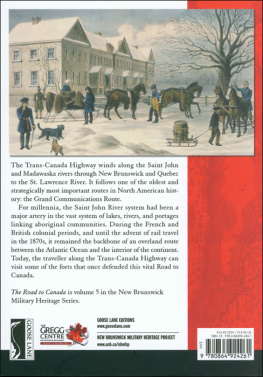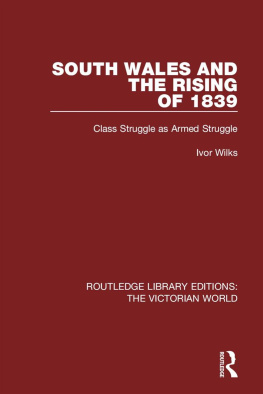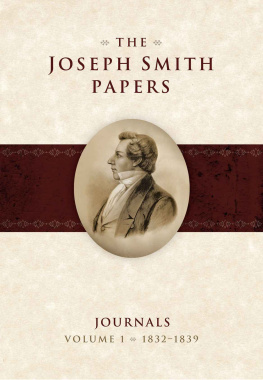

Copyright 2013 by W. E. Campbell.
All rights reserved. No part of this work may be reproduced or used in any form or by any means, electronic or mechanical, including photocopying, recording, or any retrieval system, without the prior written permission of the publisher or a licence from the Canadian Copyright Licensing Agency (Access Copyright). To contact Access Copyright, visit www.accesscopyright.ca or call 1-800-893-5777.
Edited by Brent Wilson and Barry Norris.
Front cover illustration: Fort Fairfield, July 1839 by Lieutenant Philip John Bainbrigge, Royal Engineers courtesy of Library and Archives Canada (G1139.71.P2B341840).
Firearms photos on cover courtesy of the National Firearms Museum and the Fredericton Region Museum.
Cover design by Julie Scriver.
Book design by Chris Tompkins.
Library and Archives Canada Cataloguing in Publication
Campbell, W. E. (William Edgar), 1947-
The Aroostook War of 1839 [electronic resource] / W.E. (Gary) Campbell.
(New Brunswick military heritage series; 20)
Includes bibliographical references and index.
Electronic monograph in HTML format.
Issued also in print format.
Co-published by: Gregg Centre for the Study of War and Society.
ISBN 978-0-86492-756-9
1. Aroostook War, 1839. 2. Maine--History, Military--19th century.
3. New Brunswick--History, Military--19th century. I. Gregg Centre for
the Study of War and Society II. Title. III. Series: New Brunswick military heritage series (Online); 20
E398.C34 2013 974.103 C2012-907752-6
Goose Lane Editions acknowledges the generous support of the Canada Council for the Arts, the Government of Canada through the Canada Book Fund (CBF), and the Government of New Brunswick through the Department of Tourism, Heritage, and Culture.
Goose Lane Editions
Suite 330, 500 Beaverbrook Court
Fredericton, New Brunswick
CANADA E3B 5X4
www.gooselane.com
New Brunswick Military Heritage Project
The Brigadier Milton F. Gregg, VC,
Centre for the Study of War and Society
University of New Brunswick
PO Box 4400
Fredericton, New Brunswick
CANADA E3B 5A3
www.unb.ca/nbmhp
As I explore and research the past and learn how it shaped our present, I would like to dedicate this book to my contacts with the future, my granddaughter Calleigh Campbell and my grandsons Malcolm Campbell and Nicholas Jacula.
Contents
Origins of the Disputed Territory
Maine Struggles to Gain Its Inheritance
The Maine Armed Posse Encounters the Lumbermens Resistance
On the Brink of War
The Disputed Territory Partitioned
The Ashburton-Webster Treaty
Prologue
On the cold winters night of February 11/12, 1839, a diverse group of travellers gathered at the home of James Fitzherbert, in what would later become Fort Fairfield, Maine. In keeping with the custom of the time, Fitzherberts home was open to travellers seeking meals and lodging. But this was no ordinary group of travellers, and what transpired that evening nearly precipitated a third Anglo-American war.
Among the travellers was Rufus McIntire, the newly appointed land agent for the state of Maine. He was moving with a posse down the Aroostook River, in what was called the Disputed Territory, driving away lumbermen who had been illegally cutting timber. Believing the trespassers had all fled across the Commissioners Line into the province of New Brunswick, McIntire had left the rest of the Maine posse behind and, accompanied by three other Americans Gustavus G. Cushman, Thomas Bartlett, and Captain J.H. Pilsbury retired to Fitzherberts for warmth and shelter. They were later joined by another American, Colonel Ebenezer Webster. Unbeknownst to them, the lumbermen had kept McIntire and his party under observation as they retreated across the Disputed Territory and back into New Brunswick. Seeing an opportunity to strike back, a group of between fifteen and eighteen lumbermen led by Asa Dow left their base at Tibbitss house in present-day Perth-Andover, New Brunswick, and made their way to Fitzherberts. Arriving about midnight, they entered the house and captured the five Americans. When asked by what authority they were acting, one of the lumbermen, Punderson Beardsley, pointed to his gun and replied that is my authority!
The lumbermen placed the Americans in a sleigh and took them down the St. John River to Fredericton to stand trial. Meanwhile, Sheriff Hastings Strickland, the leader of the Maine posse, rode through the depths of winter to Augusta to deliver the news to Governor John Fairfield. Fairfield quickly responded by sending reinforcements into the Disputed Territory in support of the posse. When news of the capture of McIntire and his colleagues reached the lieutenant-governor of New Brunswick, Sir John Harvey, he warned the provincial militia for duty should it become necessary to oppose the incursion by Maine into the Disputed Territory. Fairfield, hearing that the New Brunswick militia had been alerted for duty along the undefined border, responded by mobilizing the Maine militia. The Aroostook War had begun.
Within days of the capture of Rufus McIntire, forces began to move that, if left unchecked, would have plunged Britain and the United States into their third war in barely fifty years. At issue was a boundary left unsettled from the American Revolution a half-century earlier, vast timber resources, and the strategic British line of communications that ran through the Disputed Territory to the isolated settlements of Upper and Lower Canada.
Chapter One
Origins of the Disputed Territory
[F]rom... that angle which is formed by a line drawn due north from the source of St. Croix River to the highlands... which divide those rivers
Treaty of Paris, Article 2, signed September 3, 1783
The Aroostook War, variously referred to as the Lumbermens War, the Pork and Beans War, or the Bloodless Aroostook War, is generally considered to have been a tempest in a teapot, and an almost comic opera-like affair. It was much more than this, however, and it was certainly more serious. Looking back over 174 years, it is difficult to understand why the Aroostook Valley, where a minor border crisis occurred in the depths of winter, could have become a flashpoint in relations between Britain and the United States. Yet it was, and though the subject of much mockery, the Aroostook War almost led to a third Anglo-American war.
The reasons for the confrontation were found in the Maine-New Brunswick border dispute, which began with the Treaty of Paris in 1783 that ended the American Revolutionary War and lasted until the British Parliament endorsed the Ashburton-Webster Treaty sixty years later. At issue for the new state of Maine was its inheritance from the Treaty of Paris, while New Brunswick wished to claim its share of what was considered disputed territory. But the key difference between the two sides was the British governments determination to secure the Grand Communications Route to the Canadas. In an era before railways and powerful steamships, the winter road along the St. John River and over the portage to the St. Lawrence River was a route of great strategic importance and one worth fighting for.













